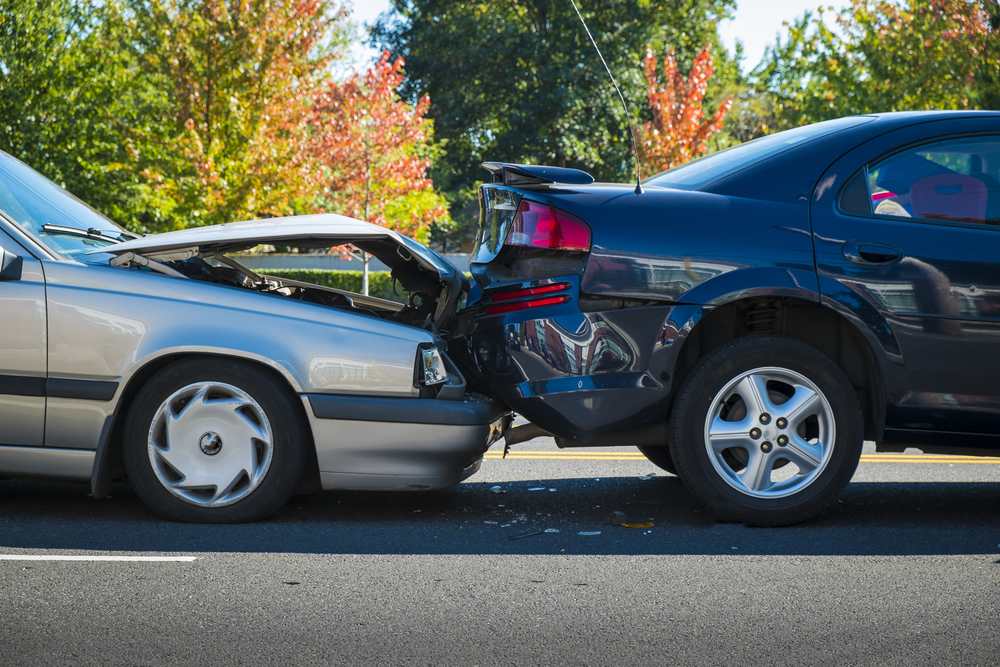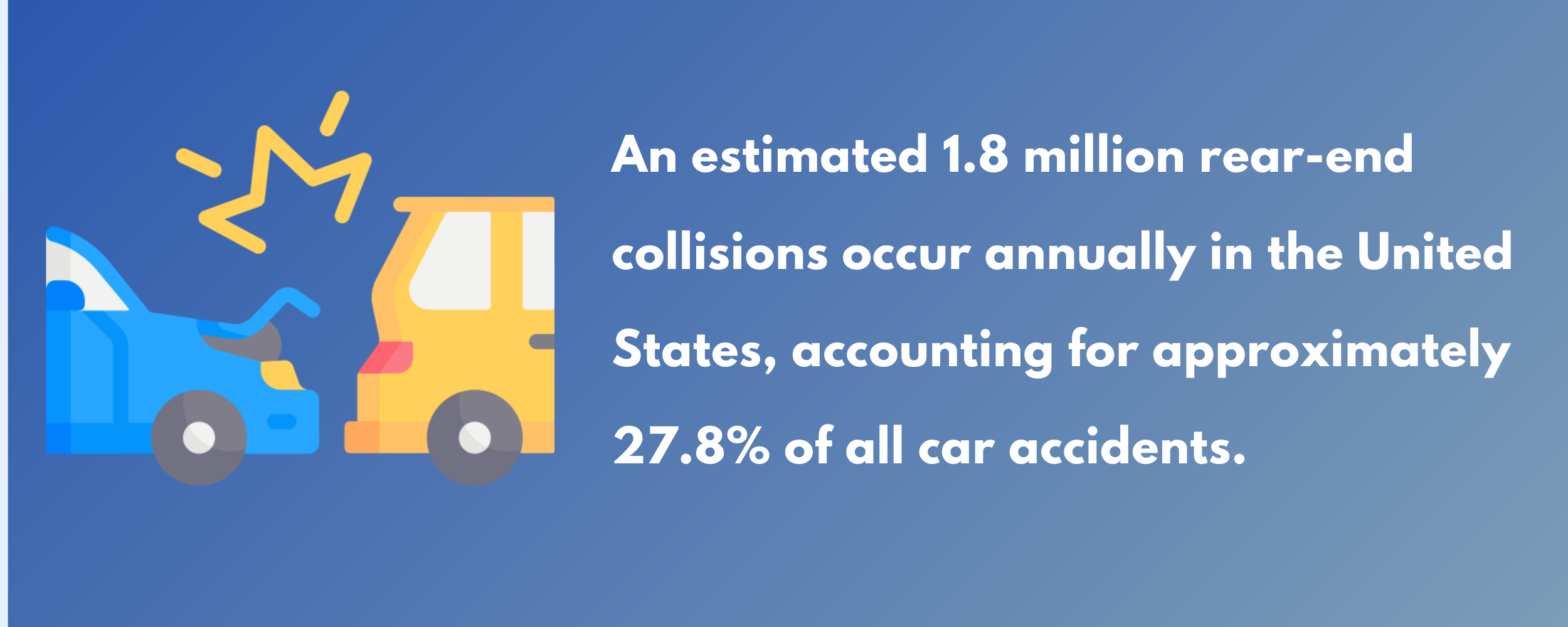Driving can be unpredictable and dangerous, whether you are a newly-licensed driver or a seasoned motorist. Rear-end collisions are one of the most common types of accidents on American roads, and they can happen to even the most careful drivers.
We have compiled a list of the top eleven rear-end collision statistics that all car owners need to know. Buckle up as we review the eye-opening facts that will help you to be more aware of the risks on the road and avoid these types of crashes.

1. An estimated 1.8 million rear-end collisions occur annually in America.
Rear-end collisions are the most common type of road traffic accident. According to the latest data from the National Highway Traffic Safety Administration (NHTSA), there were 1,457,155 rear-end collisions in 2020. This number is the highest of all crash types, accounting for 27.8% of total accidents.
A worthy note is that 2020 being the Covid year, there was less than general vehicular movements and thus resulting in lesser accidents. For reference, in 2019, there were 2,194,498 reported rear-end collisions which is 34% more than the 2020 numbers. Historically, on average, an estimated 1.8 million rear-end collisions are recorded in America every year.

2. Rear-end collisions are the second largest cause of all non-fatal crash injuries
While the overwhelming majority of rear-end crashes only result in property damage (1,037,665 collisions or 71.2% of all rear-end crashes), they are the second largest cause of all non-fatal crash injuries, accounting for 417,062 injury-causing accidents (26.2%) in 2020.
3. Rear-end collisions are one of the top 10 causes of fatal crashes
Based on the 2020 data, rear-end crashes are the 7th most deadly type of road traffic accident, contributing to 2,428 fatal collisions (6.8%). Looking at other collision types involving moving vehicles, angle crashes (crashes that are not head-on, rear-end, rear-to-rear, or sideswipe) caused the most fatalities (6,432 collisions), followed by head-on crashes (3,631 collisions).
4. The number of rear-end crashes decreased by 34% in 2020 vs 2019
Unsurprisingly, the overall number of road traffic accidents decreased year-on-year between 2019 and 2020, partly due to the Covid-19 pandemic and resulting lockdowns. However, rear-end collisions were reduced by a third, from 2,194,498 incidents in 2019 to 1,457,155 incidents in 2020. This decrease of 737,343 equates to 49% of the net reduction of all collision types from 6,756,084 incidents in 2019 to 5,250,837 incidents in 2020.
5. Advanced driver assistance systems prevent 40% of rear-end crashes
A study by the Insurance Institute for Highway Safety (IIHS) showed that cars fitted with forward collision warning reduced the risk of rear-end crashes by 23%. Paired with autonomous emergency braking (AEB), rear-end collisions decreased by 40% on average, and the risk of injury fell by 42%.
6. Reducing Speed By 13mph Decreases Rear-end Crash Damages By 80%
The IIHS conducted two rear-end crash tests at two different speeds to highlight the difference in damage in cars with and without Autonomous Emergency Braking (AEB). The experiment revealed that at 25mph, a car rear-ending a stationary car caused $28,000 worth of damage across both vehicles. The stationary car was a write-off. Reducing the speed by just 13mph, to mimic the impact of using AEB, slashed the total cost of damage to $5,700 (80% lower).
7. 20 Car Manufacturers Have Committed To Preventing Rear-end Collisions
A joint enterprise between the IIHS and the NHTSA convinced 20 automakers, who represent 99% of U.S. light vehicle sales, to agree to equip all new cars and SUVs with front crash prevention systems as standard by September 2022. 12 of the 20 manufacturers met that target last year.
8. Rear-end collisions involving pickup trucks are 2½ times as likely to be fatal than those involving passenger cars
Pickup trucks are big and heavy, making them more than 2½ times as likely to cause deadly crashes than regular cars. This statistic is especially true in rural areas where people tend to drive faster than on urban roads, and there are not as many streetlights. In 2020, almost 30% of rear-end collisions caused by pickups happened when they were going 55mph or faster, compared to only 23% for cars.
9. Only 3% of rear-end crashes happen at speeds of 25mph or less
A recent study conducted by the IIHS analyzed all police-reported crashes from 2016 to 2019. The data revealed that just 3% of all rear-end collisions and 1% of fatal crashes happened in vehicles traveling on roads with a speed limit of 25mph or less. Conversely, 70 percent of fatal rear-end crashes happened in areas with a speed limit of 55mph or higher.
10. The average settlement amount for a rear-end collision is $20,000 to $30,000
The size of an insurance payout will depend on the severity of injuries, any evidence of negligence, the speed of the collision, and the type of vehicles involved. On average, the settlement amount for a rear-end collision is between $20,000 and $30,000. However, these numbers are skewed upwards by a handful of six- and seven-figure pay.outs. Excluding these large payments, the more realistic average is $10,000 to $15,000
11. Rear-end collisions are about 60% cheaper to repair than front-end collisions
The average cost of repairing a rear-end collisions is about $2,000 while a front-end collision repair typically comes out in range of $5,000 to $7,500. A front-end collisions involves a more vital components and thus it’s obvious to be a costlier repair. More often than not, rear end collisions are limited to structural, back bumper and tail light damage.
What are the most common causes of rear-end collisions?
The blame for rear-end collisions is almost always placed on the driver of the striking vehicle because it is their responsibility to maintain a safe distance from the vehicle in front. Here are the most common reasons why these crashes happen:
- Tailgating: 21% of US drivers admit to tailgating another vehicle. Following another vehicle too closely can make it difficult to stop in time if they suddenly brake. To maintain a safe stopping distance, a good rule of thumb is to leave a 3-second gap between your car and the one in front.
- Distracted driving: Taking your eyes off the road to check your phone, adjust the radio, or engage in other activities can cause you to miss important cues and increase your risk of a rear-end collision. In fact, texting increases your chances of rear-ending a vehicle by a factor of 7.
- Speeding: Driving at high speeds can reduce your reaction time and make it difficult to stop in time, especially in heavy traffic or adverse weather conditions. Speeding remains the number one contributing factor in fatal car accidents.
- Poor visibility: Limited visibility due to fog, rain, or snow can make it difficult to see the road ahead and the vehicles in front of you, increasing the risk of a rear-end collision. In poor driving conditions, drivers should reduce their speed and increase the stopping distance between their vehicle and the one in front.
- Fatigue: Driving while fatigued can impair your reaction time and judgment. Worryingly, 35% of US drivers sleep less than the recommended seven hours daily, which almost doubles the risk of being involved in an accident.
Conclusion
Although rear-end collisions are common, it is comforting to know that they rarely end in tragedy. However, to avoid injury and property damage, drivers can take preventative measures to dramatically reduce the chances of rear-ending another vehicle, such as maintaining a safe following distance, avoiding distractions, and staying alert at all times. Upgrading to a car equipped with forward collision warning and AEB will further reduce the risk of being involved in a crash. Taking these simple steps will help to make American roads a safer place to drive.
Sources:
- https://crashstats.nhtsa.dot.gov/Api/Public/ViewPublication/813375
- https://crashstats.nhtsa.dot.gov/Api/Public/ViewPublication/813141
- https://www.iihs.org/news/detail/front-crash-prevention-slashes-police-reported-rear-end-crashes
- https://www.iihs.org/topics/advanced-driver-assistance#Rear-collision-prevention
- https://www.newsweek.com/iihs-switching-crash-test-methodology-due-advances-safety-tech-1703768
- https://www.iihs.org/news/detail/autobrake-slashes-rear-end-crash-rates-for-pickups-but-few-are-equipped
- https://www.newsweek.com/iihs-switching-crash-test-methodology-due-advances-safety-tech-1703768
